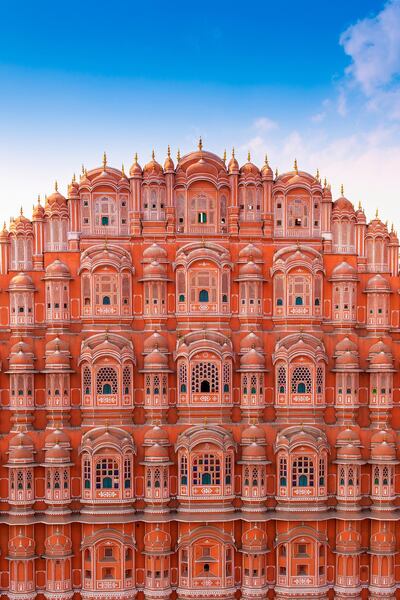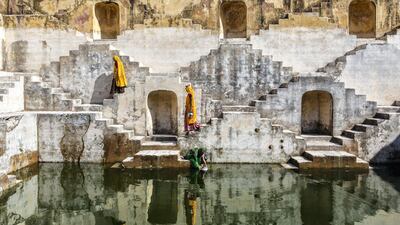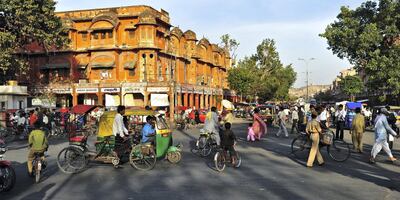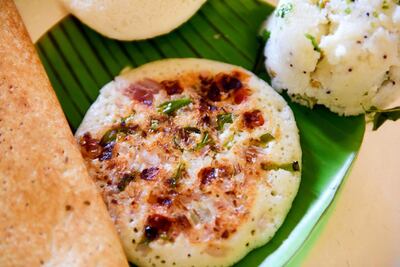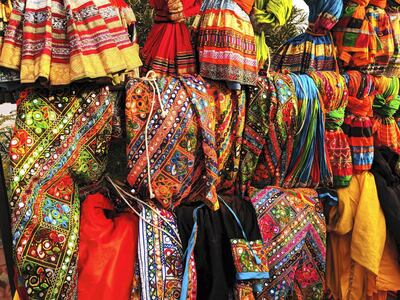Jaipur is similar to an onion, full of layers just waiting to be peeled back. Breathtaking architecture, colourful shopping, varied accommodation options and flavour-charged gastronomic fare make this Indian city a deeply immersive travel destination.
Founded in 1727 by Rajput king Sawai Jai Singh II, the fortified metropolis, located in India's north-western desert state of Rajasthan, is also known as the "Pink City" because of the rose-hued clusters of historical buildings that pepper it like confetti.
Jaipur's unique architecture and culture earned it a Unesco World Heritage Site designation in July. "Unlike other cities in the region located in hilly terrain, Jaipur was established on the plain and built according to a grid plan interpreted in the light of Vedic architecture," Unesco explains on its website.
“The streets feature continuous colonnaded businesses that intersect in the centre, creating large public squares called chaupars. Markets, stalls, residences and temples built along the main streets have uniform facades. The city’s urban planning shows an exchange of ideas from ancient Hindu and modern Mughal, as well as Western cultures … Designed to be a commercial capital, the city has maintained its local commercial, artisanal and co-operative traditions to this day.”
Here is our comprehensive guide for exploring the city.
A comfortable bed
As one of India's most popular tourist destinations, Jaipur is chock-a-block with attractive accommodation options – from five-star to no star. Seeking a hotel fit for a nawab? Look no further than Rambagh Palace, the erstwhile residence of the maharajas, located right in the heart of town. Think eye-popping opulence and extravagantly decorated suites, with four-poster beds, period furniture, marble bathrooms and lush views over the landscaped Mughal Gardens. Rooms cost from $400 (Dh1,469) per night; www.tajhotels.com.
Jaipur Marriott Hotel combines modern delights with traditional hospitality. Located near Jawahar Circle, which locals claim to be the biggest circular park in Asia, it offers lavish rooms and suites. Saffron restaurant will tickle your taste buds. Rooms cost from $120 per night; www.marriott.com.
As one of the Pink City’s first privately owned slices of real estate to be turned into a boutique hotel, Samode Haveli is the former residence of the rulers of the kingdom of Samode. Soothing pastel-hued rooms, an inviting pool and unobtrusive service make it a very popular stay. Expect to pay about $150 per night; www.samode.com.
Find your feet
Jaipur's streets demand to be roamed. The old walled city, with its ancient gates and markets, is endlessly fascinating. You could spend days ambling around and unravelling its mysteries. But make sure to punctuate your explorations with visits to other famous sites, such as the Hawa Mahal (Palace of Winds), an 18th-century, five-storey screened porch with 953 windows. The city's most defining architectural landmark flaunts intricate latticework and was designed to allow royal ladies to watch the city from the palace, while remaining in purdah.
The colonnaded City Palace, with its beautifully laid out courtyards and museums, is an ode to a bygone era. Chandpole, a bustling old-town cluster of narrow lanes and pink buildings, is where you can watch vendors trade the old-fashioned way, plying marble, textiles, cotton quilts and traditional chess sets.
However, the most exquisite of all Rajput buildings is Amber Fort, a Unesco World Heritage Site crafted from pale yellow and pink sandstone and white marble. Located 11 kilometres away from the city and perched on a hilltop in the Aravalli Range, it is fringed by the glassy Maota Lake. One of its complexes – the Sheesh Mahal (Mirror Palace) – has inspired poets and writers for centuries, with walls and ceilings encrusted with glass and mirror work.
Meet the locals
The best way to interact with Jaipur’s friendly residents is to visit local handicrafts centres. The Anokhi Museum of Hand Printing is housed in a magnificently restored haveli (mansion) near the famous Badrinath Temple and offers the opportunity to interact with local artisans, who toil to keep the city’s famous textile legacy alive. The museum itself is a trove of hand-block printed textiles, images, tools and related objects, offering a fascinating insight into this hallowed craft.
For a local of a different kind, visit Elefantastic, an elephant sanctuary located on the outskirts of the city, where you can get up-close and personal with these gentle giants and their caretakers. Elephants were prolifically used by Rajput warrior kings during both wartime and public occasions, so they have an old association with Jaipur. Elefantastic works with low-income, marginalised caretaker families to provide welfare services and to educate people about the plight of Asian elephants. You can wash, feed and water the tuskers and learn about their "make up", as well as their ailments and treatments, directly from their keepers.
Book a table
When you’re not seeking out museums or palaces, or having a chinwag with the locals, you’d do well to pamper your palate in a city that serves up notoriously tasty fare. Eschew standard restaurant offerings and trawl labyrinthine lanes for Jaipur’s mouthwatering street food. It is fresh, delicious and cheap. What’s not to love?
Begin with pyaz ki kachori from Rawat Mishtan Bhandar, located on Station Road. Ignore the sound of noisy vehicles and teeming crowds to focus instead on the deep-fried dough balls, bursting with piquant spices, onions and potatoes and paired with hot sauces. Follow this up with a visit to Lassiwala on MI Road for the creamiest and foamiest lassi around, served in clay cups. The serpentine queues witnessed here at all times attest to its popularity. Food theatre comes free of charge, as you watch the chefs prepare the delectable drink fresh in front of you.
Wrap up your food safari with a plate of delicious matka kulfi, loaded with falooda (chilled noodles), at shop number 28 on Link Road at Bapu Bazaar. Thrusting crowds notwithstanding, the ambrosial dessert makes the effort worth it. Celebrity spotting is a bonus, as you just might bump into a Bollywood celebrity or two queuing up next to you.
Don’t miss
End your day by watching the Sound and Light show at the nearby Maota Lake. The entertainment combines acoustics, folk music and stellar lighting, to bring to life legends about the 28 kings of the Kachhwaha dynasty. Don’t forget to book in advance.
Shopping
With an array of handicrafts, silver jewellery, bangles, textiles, apparel, fabrics and carpets on sale for astonishing prices, Jaipur is a shopaholic's dream. Peruse colourful markets such as Johri Bazaar, Bapu Bazaar, Badi Choupad and Hawa Mahal for the best buys. Don't forget to haggle, though, as this can often miraculously whittle down the price by nearly half.
Take your time discovering the specialised markets, too. The wholesale flower market (phool mandi), ensconced within the folds of Chandi ki Taksal gate in the Old City, is eminently Instagrammable. Its pugree-clad merchants put out stunning and fragrant flower displays and floral art, while attending to business with lyrical grace.
What to avoid
Avoid the city’s crowded bazaars at peak time. Don’t leave your bags unzipped while walking through the busy markets. Beware of touts who hang around famous sites promising “good deals”. It is best to pre-book a tour with a reputed agency to get the most from your visit.
Getting there
Many Indian airlines – including Air India – fly directly into Jaipur from Dubai and Abu Dhabi, with return flights starting from Dh1,000.
How Alia's experiment will help humans get to Mars
Alia’s winning experiment examined how genes might change under the stresses caused by being in space, such as cosmic radiation and microgravity.
Her samples were placed in a machine on board the International Space Station. called a miniPCR thermal cycler, which can copy DNA multiple times.
After the samples were examined on return to Earth, scientists were able to successfully detect changes caused by being in space in the way DNA transmits instructions through proteins and other molecules in living organisms.
Although Alia’s samples were taken from nematode worms, the results have much bigger long term applications, especially for human space flight and long term missions, such as to Mars.
It also means that the first DNA experiments using human genomes can now be carried out on the ISS.
The bio
Studied up to grade 12 in Vatanappally, a village in India’s southern Thrissur district
Was a middle distance state athletics champion in school
Enjoys driving to Fujairah and Ras Al Khaimah with family
His dream is to continue working as a social worker and help people
Has seven diaries in which he has jotted down notes about his work and money he earned
Keeps the diaries in his car to remember his journey in the Emirates
Emergency phone numbers in the UAE
Estijaba – 8001717 – number to call to request coronavirus testing
Ministry of Health and Prevention – 80011111
Dubai Health Authority – 800342 – The number to book a free video or voice consultation with a doctor or connect to a local health centre
Emirates airline – 600555555
Etihad Airways – 600555666
Ambulance – 998
Knowledge and Human Development Authority – 8005432 ext. 4 for Covid-19 queries
RESULTS
6.30pm Handicap (TB) US$65,000 (Dirt) 1,400m
Winner Golden Goal, Pat Dobbs (jockey), Doug Watson (trainer)
7.05pm Dubai Racing Club Classic Listed Handicap (TB) $88,000 (Turf) 2,410m
Winner: Walton Street, William Buick, Charlie Appleby.
7.40pm Dubai Stakes Group 3 (TB) $130,000 (D) 1,200m
Winner Switzerland, Tadhg O’Shea, Satish Seemar
8.15pm Singspiel Stakes Group 3 (TB) $163,000 (T) 1,800m
Winner Lord Giltters, Adrie de Vries, David O’Meara
8.50pm Al Maktoum Challenge Round-1 (TB) $228,000 (D) 1,600m
Winner Military Law, Antonio Fresu, Musabah Al Muhairi.
9.25pm Al Fahidi Fort Group 2 (TB) $163,000 (T) 1,400m
Winner Land Of Legends, Frankie Dettori, Saeed bin Suroor
10pm Dubai Dash Listed Handicap (TB) $88,000 (T) 1,000m
Winner Equilateral, Frankie Dettori, Charles Hills.
RESULTS
Light Flyweight (48kg): Alua Balkibekova (KAZ) beat Gulasal Sultonalieva (UZB) by points 4-1.
Flyweight (51kg): Nazym Kyzaibay (KAZ) beat Mary Kom (IND) 3-2.
Bantamweight (54kg): Dina Zholaman (KAZ) beat Sitora Shogdarova (UZB) 3-2.
Featherweight (57kg): Sitora Turdibekova (UZB) beat Vladislava Kukhta (KAZ) 5-0.
Lightweight (60kg): Rimma Volossenko (KAZ) beat Huswatun Hasanah (INA) KO round-1.
Light Welterweight (64kg): Milana Safronova (KAZ) beat Lalbuatsaihi (IND) 3-2.
Welterweight (69kg): Valentina Khalzova (KAZ) beat Navbakhor Khamidova (UZB) 5-0
Middleweight (75kg): Pooja Rani (IND) beat Mavluda Movlonova (UZB) 5-0.
Light Heavyweight (81kg): Farida Sholtay (KAZ) beat Ruzmetova Sokhiba (UZB) 5-0.
Heavyweight (81 kg): Lazzat Kungeibayeva (KAZ) beat Anupama (IND) 3-2.
UAE currency: the story behind the money in your pockets
Killing of Qassem Suleimani
Sole survivors
- Cecelia Crocker was on board Northwest Airlines Flight 255 in 1987 when it crashed in Detroit, killing 154 people, including her parents and brother. The plane had hit a light pole on take off
- George Lamson Jr, from Minnesota, was on a Galaxy Airlines flight that crashed in Reno in 1985, killing 68 people. His entire seat was launched out of the plane
- Bahia Bakari, then 12, survived when a Yemenia Airways flight crashed near the Comoros in 2009, killing 152. She was found clinging to wreckage after floating in the ocean for 13 hours.
- Jim Polehinke was the co-pilot and sole survivor of a 2006 Comair flight that crashed in Lexington, Kentucky, killing 49.
3%20Body%20Problem
%3Cp%3E%3Cstrong%3ECreators%3A%3C%2Fstrong%3E%20David%20Benioff%2C%20D%20B%20Weiss%2C%20Alexander%20Woo%3C%2Fp%3E%0A%3Cp%3E%3Cstrong%3EStarring%3A%20%3C%2Fstrong%3EBenedict%20Wong%2C%20Jess%20Hong%2C%20Jovan%20Adepo%2C%20Eiza%20Gonzalez%2C%20John%20Bradley%2C%20Alex%20Sharp%3C%2Fp%3E%0A%3Cp%3E%3Cstrong%3ERating%3A%3C%2Fstrong%3E%203%2F5%3C%2Fp%3E%0A
Dhadak
Director: Shashank Khaitan
Starring: Janhvi Kapoor, Ishaan Khattar, Ashutosh Rana
Stars: 3
Six large-scale objects on show
- Concrete wall and windows from the now demolished Robin Hood Gardens housing estate in Poplar
- The 17th Century Agra Colonnade, from the bathhouse of the fort of Agra in India
- A stagecloth for The Ballet Russes that is 10m high – the largest Picasso in the world
- Frank Lloyd Wright’s 1930s Kaufmann Office
- A full-scale Frankfurt Kitchen designed by Margarete Schütte-Lihotzky, which transformed kitchen design in the 20th century
- Torrijos Palace dome
Killing of Qassem Suleimani
First Person
Richard Flanagan
Chatto & Windus
UAE currency: the story behind the money in your pockets
How to watch Ireland v Pakistan in UAE
When: The one-off Test starts on Friday, May 11
What time: Each day’s play is scheduled to start at 2pm UAE time.
TV: The match will be broadcast on OSN Sports Cricket HD. Subscribers to the channel can also stream the action live on OSN Play.
MATCH INFO
Uefa Champions League semi-final:
First leg: Liverpool 5 Roma 2
Second leg: Wednesday, May 2, Stadio Olimpico, Rome
TV: BeIN Sports, 10.45pm (UAE)
BIGGEST CYBER SECURITY INCIDENTS IN RECENT TIMES
SolarWinds supply chain attack: Came to light in December 2020 but had taken root for several months, compromising major tech companies, governments and its entities
Microsoft Exchange server exploitation: March 2021; attackers used a vulnerability to steal emails
Kaseya attack: July 2021; ransomware hit perpetrated REvil, resulting in severe downtime for more than 1,000 companies
Log4j breach: December 2021; attackers exploited the Java-written code to inflitrate businesses and governments
Conflict, drought, famine
Estimates of the number of deaths caused by the famine range from 400,000 to 1 million, according to a document prepared for the UK House of Lords in 2024.
It has been claimed that the policies of the Ethiopian government, which took control after deposing Emperor Haile Selassie in a military-led revolution in 1974, contributed to the scale of the famine.
Dr Miriam Bradley, senior lecturer in humanitarian studies at the University of Manchester, has argued that, by the early 1980s, “several government policies combined to cause, rather than prevent, a famine which lasted from 1983 to 1985. Mengistu’s government imposed Stalinist-model agricultural policies involving forced collectivisation and villagisation [relocation of communities into planned villages].
The West became aware of the catastrophe through a series of BBC News reports by journalist Michael Buerk in October 1984 describing a “biblical famine” and containing graphic images of thousands of people, including children, facing starvation.
Band Aid
Bob Geldof, singer with the Irish rock group The Boomtown Rats, formed Band Aid in response to the horrific images shown in the news broadcasts.
With Midge Ure of the band Ultravox, he wrote the hit charity single Do They Know it’s Christmas in December 1984, featuring a string of high-profile musicians.
Following the single’s success, the idea to stage a rock concert evolved.
Live Aid was a series of simultaneous concerts that took place at Wembley Stadium in London, John F Kennedy Stadium in Philadelphia, the US, and at various other venues across the world.
The combined event was broadcast to an estimated worldwide audience of 1.5 billion.
